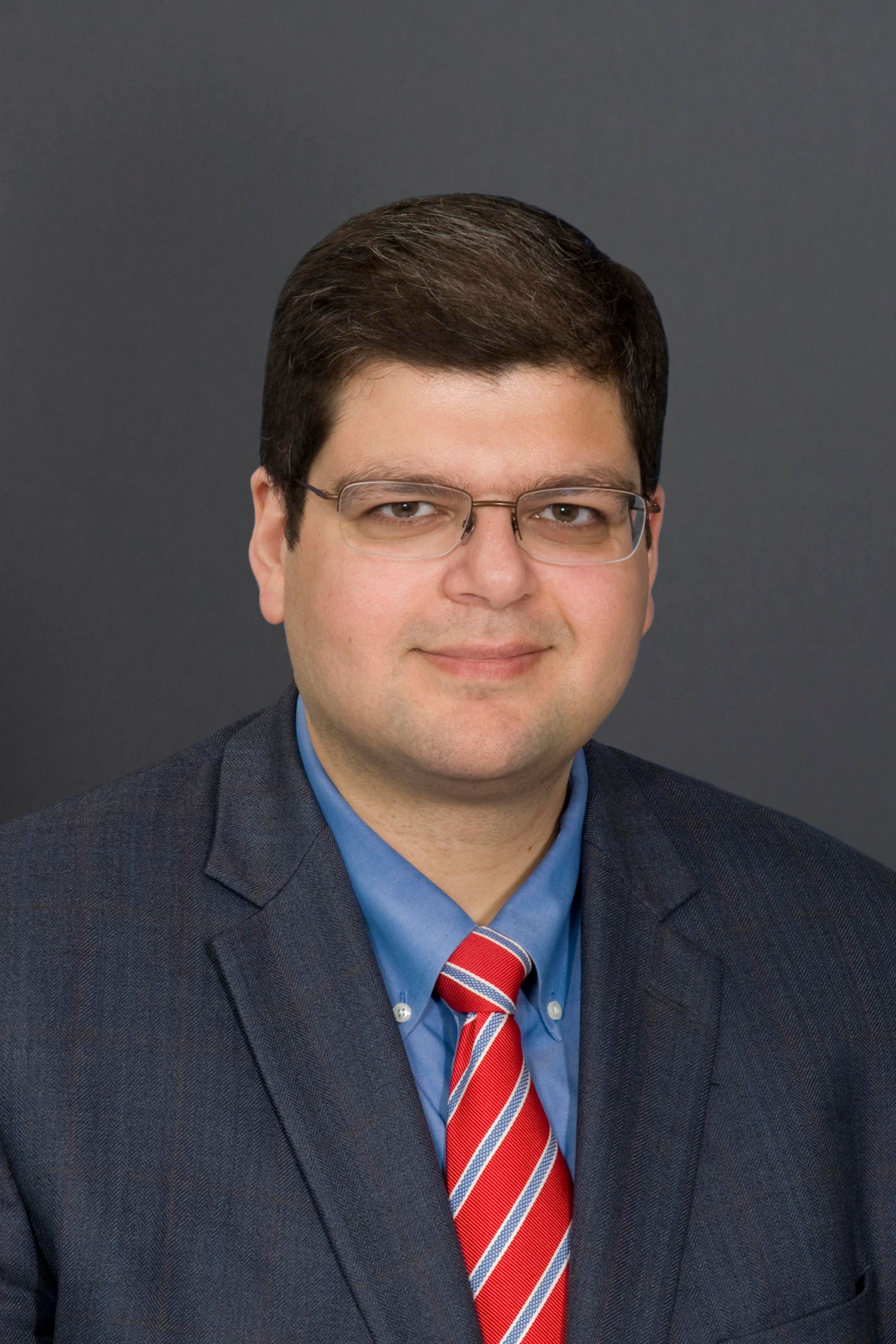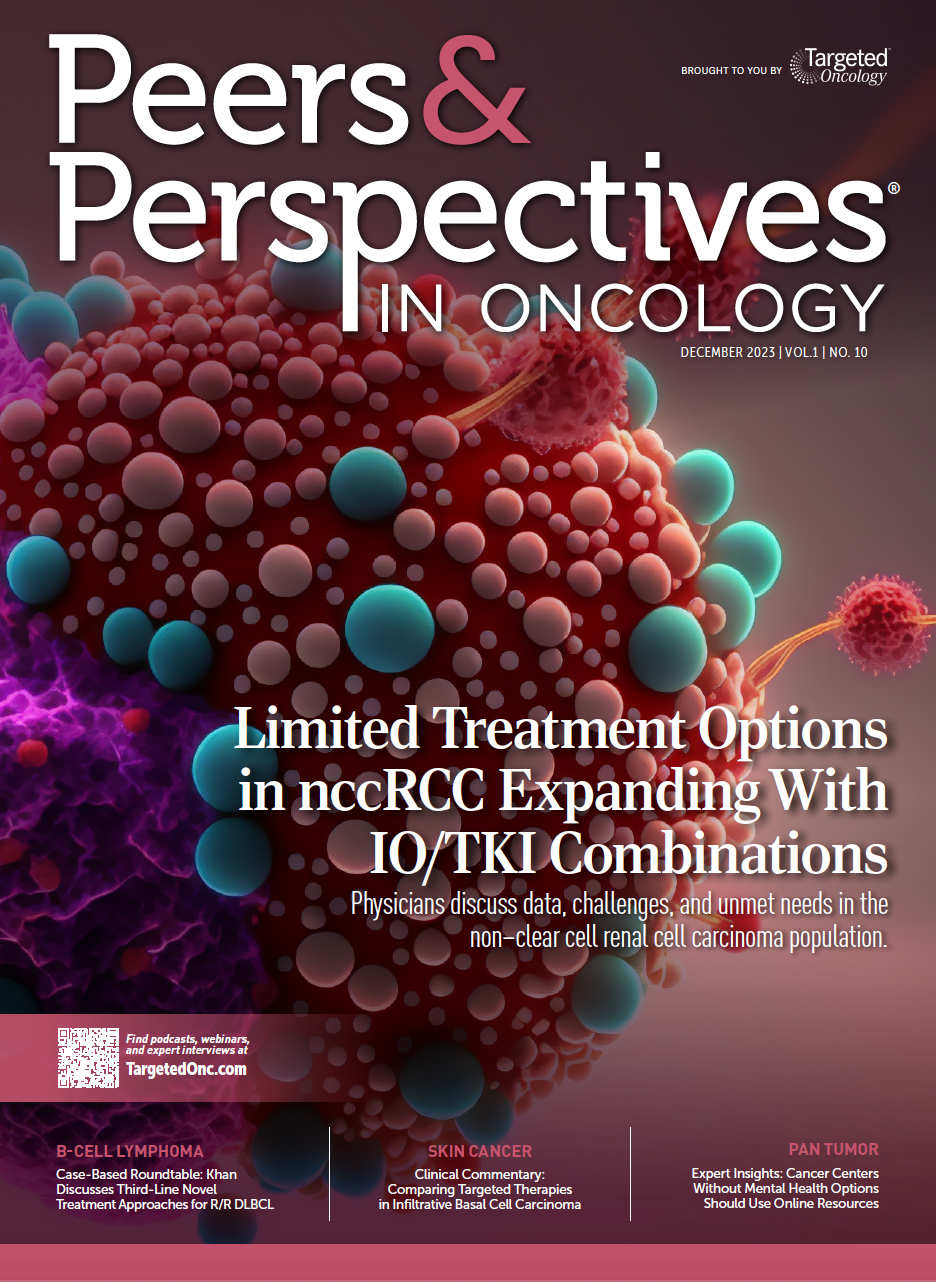Khan Discusses Third-Line Novel Treatment Approaches for R/R DLBCL
During a Targeted Oncology™ Case-Based Roundtable™ event, Cyrus M. Khan, MD, and participants discussed the case of a patient with diffuse large B-cell lymphoma who progressed after complete remission on standard-of-care frontline therapy, then had stable disease after receiving polatuzumab vedotin, bendamustine, and rituximab.
Cyrus M. Khan, MD (MODERATOR)
Hematologist
Division of Hematology and Cellular Therapy
West Penn Hospital of Allegheny Health Network
Pittsburgh, PA

EVENT REGION Pennsylvania
PARTICIPANT LIST Haixia Qin, MD, PhD | Simi Rai, MD | Naeem Latif, MD | Alexander Barsouk, MD | Gurprataap Sanhu, MD | Hayman Salib, MD | Nelson S. Yee, MD, PhD, RPh | Meher Burki, MD | Hayan Moualla, MD | Sabrina Martyr, MD
CASE SUMMARY
A 73-year-old woman presented with fever, headaches, and 7-lb unintentional weight loss. She is married with 2 grown children who live in other states; she is the primary caretaker for her mother who has advanced dementia, and there is no family history of cancer. She has hyperlipidemia, which is well controlled with simvastatin. Physical examination shows palpable bilateral cervical lymphadenopathy.
Laboratory results include lactate dehydrogenase level of 300 U/L (280 U/L upper limit), hemoglobin level of 10.8 g/dL, bilirubin level of 1.3 mg/dL (1.2 mg/dL upper limit), and creatinine level of 1.7 mg/dL (1.2 mg/dL upper limit), with all other levels within normal limits. She has negative results for hepatitis B, hepatitis C, and HIV. A lymph node biopsy result with immunohistochemistry panel shows she has CD10-positive and CD20-positive confirmed diffuse large B-cell lymphoma (DLBCL); fluorescence in situ hybridization result is negative for rearrangements of BCL6, BCL2, and cellular MYC.
A whole-body PET/CT scan showed diffuse adenopathy, with the largest node of 3.9 cm, and MRI of the brain showed no evidence of lesions. Her ECOG performance status is 1. Her DLBCL is stage III and low-intermediate risk per International Prognostic Index. The patient received 6 cycles of R-CHOP (rituximab [Rituxan], cyclophosphamide, doxorubicin hydrochloride [hydroxydaunorubicin], vincristine sulfate [Oncovin], and prednisone), which was well tolerated and led to a complete remission at the end of treatment.
One year later, the patient presents with diffuse lymphadenopathy, confirmed by PET-CT scan. A biopsy result shows relapse of the same DLBCL. She received 6 cycles of pola-BR (polatuzumab vedotin [Polivy], bendamustine [Bendeka], and rituximab) and had stable disease for 6 to 8 months before progression. She is not able to travel because she is the primary caretaker for her mother who has dementia. She receives loncastuximab tesirine (Zynlonta) as third-line therapy.
DISCUSSION QUESTIONS
- Do you agree with the treatment choice for this patient?
- What other therapeutic options could be considered?
QIN: I haven’t had a chance to treat [with this therapy] in a refractory setting. I graduated this past year. I was in a CAR [chimeric antigen receptor] T-cell center, so I have more experience on how to do CAR T-cell therapy. I haven’t had a good opportunity for this yet.
KHAN: I’m sure you’ll get many opportunities in the future. Dr Rai, have you treated these kinds of patients yet?
RAI: This would be somebody for whom you wouldn’t consider ASCT [autologous stem cell transplant], [with progression] after more than 12 months. And she has all these other issues and is an older patient, so I would consider loncastuximab.
KHAN: Yes, and she can’t travel, so you can’t even go out for CAR T-cell therapy. [Are there] any other options in your mind? What would you say if the patient [experiences] relapse even after loncastuximab? It would be tough for the patient.
RAI: I would…go back to a chemotherapy regimen.
LATIF: Yes, I agree with that. I practice in Lancaster, [Pennsylvania], where you sometimes come across these patients.
I sometimes try chemotherapy [and] then go by the NCCN [National Comprehensive Cancer Network] guidelines.
KHAN: Do [any of you] have experience with loncastuximab? A lot of these patients end up in the bigger centers where they’re offering different options, so you might not have an opportunity. It’s a relatively new drug.
SANHU: I have not used it, but one of my colleagues in my practice used it…and we did struggle a little with cytopenias. I didn’t follow the patient long enough to be able to tell you exactly what issues you may face with loncastuximab.
SALIB: Is the elevation of the liver enzyme [levels associated with loncastuximab caused by] inflammation or damage to the liver cells?
KHAN: It’s inflammation because it’s reversible.1 If you give the patients a break, then it reverses.
SALIB: Is the pancytopenia that we see also reversible?
KHAN: It is reversible. That’s why you can do those adjustments. You reduce the dose, or you give a longer break. Sometimes, I’ve given every 4 weeks rather than every 3 weeks, so it is reversible.
DISCUSSION QUESTIONS
- Does the approval of loncastuximab address an unmet need in the treatment of patients with relapsed/refractory (R/R) DLBCL?
- In which patient population is loncastuximab most suitable? Are there any instances in which you choose not to use loncastuximab
YEE: Based on the efficacy data, it shows good efficacy at this late line of treatment [From the Data1]. It’s also convenient; it’s off the shelf. We don’t have concern about any cytokine release syndrome [CRS] or neurotoxicity. This is a good option at this line of therapy.
KHAN: [Are there] any instances where you wouldn’t use loncastuximab?
YEE: No, I don’t think there’s any situation.
KHAN: What about compared with other therapies that are available? We have bispecifics, which are new. We have pola-BR, and we have tafasitamab [Monjuvi]/lenalidomide [Revlimid].
YEE: This is an antibody-drug conjugate, so it provides cancer target specificity. That’s a help to reduce the treatment-associated toxicity. Compared with a bispecific T-cell engager, those also potentially produce CRS and neurotoxicity. Several advantages of loncastuximab [are] good efficacy, convenience, [and availability] off the shelf.
BURKI: I think it’s a good option, and it’s a relatively easier drug to administer. There are no special things such as inpatient admissions needed…Especially if [they need to be treated] in the community, it is a good option.
KHAN: [Are there] any instances where you wouldn’t do this, or [do you see] any comparison with other treatment options?
BURKI: I personally have not used it, but from what the data show, I am optimistic that I would use it.
KHAN: [Note that] there is a dexamethasone premedication to this, 4 mg twice a day, given the day before, the day of, and the day after [initiation].2
DISCUSSION QUESTION
- For which patients do you consider using tafasitamab plus lenalidomide?
BARSOUK: How do you decide between tafasitamab/lenalidomide and loncastuximab? They were approved with approximately the same indications, [with] tafasitamab/lenalidomide [approved for 1 line] sooner, but [for] somebody who [experienced progression] after 2 lines of therapy, how do you decide?
KHAN: [For] tafasitamab/lenalidomide, we don’t have [many] data post CAR T-cell therapy, so for example, if I have a patient who had those prior lines of therapy and they’ve had CAR T-cell therapy, we have data in using loncastuximab,3 so I will go with loncastuximab. We also don’t have data for tafasitamab/ lenalidomide in patients with double- or triple-hit lymphomas, [because] they were not included in the trial.4 They were included in the [cohort of] patients who [received] loncastuximab, so I would use that.1
For any other [patient], it would be a toss-up...Even in DLBCL, many patients [respond] very differently. I like this regimen for patients who are not [experiencing aggressive progression]…For those patients, we get time to treat with this and they [likely] tolerate it. They can be home most of the time for the infusions, etc, so you can use it in those settings.
I had a patient aged 78 years [who experienced] relapse after R-CHOP and didn’t tolerate R-CHOP very well. EF [ejection fraction] was approximately 15%, so naturally, she was not a candidate for either CAR T-cell therapy or ASCT. I started this regimen, and she had a response. We irradiated that residual disease site about 8 months after treatment, and it has been 2 to 3 years. She’s still in remission, so it can work for those kinds of patients.
BARSOUK: In the loncastuximab trials, were patients with primary refractory disease included?
KHAN: Yes, in the loncastuximab trial, they were included.1 They included a lot of those hard-to-treat patients.
BARSOUK: So those patients with very aggressive refractory [disease] will probably be better candidates for loncastuximab rather than tafasitamab/lenalidomide.
KHAN: Yes, and the median line of therapy on that trial was 3. On this one it was 2,1,4 so there are very big differences in the kinds of patients who were looked at. Have you used tafasitamab/lenalidomide?
BARSOUK: No, not yet. But I have to say that both regimens seem to be quite doable in the community in that they probably would not need to be started in a tertiary care center.
KHAN: That is correct.
BARSOUK: [As Dr Yee] mentioned [concerning loncastuximab], there is no significant CRS, no CNS [central nervous system] toxicity. Neutropenia and cytopenia can be managed, [so] I would be able…to treat.
MOUALLA: I have used tafasitamab/lenalidomide, and it is very well tolerated, especially if you don’t use 25 mg of lenalidomide [daily]. So you start with 15 mg or 20 mg, especially if the patient is older. Glomerular filtration rate is not always well represented by serum creatinine. I used it in 2 [patients 80 years or older], both at 15 mg of lenalidomide. Both had nice benefit for at least a year, one of them for quite a bit more than a year, and it was very well tolerated.
BARSOUK: What about in terms of double-hit, triple-hit, or even non–germinal center pathology? Does this make any difference in this decision?
KHAN: [Patients with] double- and triple-hit [disease] were excluded from the tafasitamab/lenalidomide trial.4 They were included in the loncastuximab trial.1 As far as ABC [activated B cell] and GCB [germinal center B cell], both work, but lenalidomide does have a preferential efficacy in the ABC subtype or the non-GCB, because we know that lenalidomide works there…5 but so did loncastuximab.1 That wouldn’t play a big role, but the double- or triple-hit option would, [and] the line of treatment and the aggressiveness of the disease [would].
BARSOUK: Do you look for a proliferation index [such as] Ki-67 if it’s very high?
KHAN: That wasn’t looked at, but that would give me an idea. It would go along with a very aggressive subtype, but it doesn’t play a big role.
MARTYR: Do we happen to know the upper limit of the ages of the patients enrolled in those trials?
KHAN: In LOTIS-2 [NCT03589469], which was the loncastuximab trial, the upper age was set, so the age range was 56 to 71 years.1 The highest age in L-MIND [NCT02399085] was 86 [years].4
REFERENCES:
1. Caimi PF, Ai W, Alderuccio JP, et al. Loncastuximab tesirine in relapsed or refractory diffuse large B-cell lymphoma (LOTIS-2): a multicentre, open-label, single-arm, phase 2 trial. Lancet Oncol. 2021;22(6):790-800. doi:10.1016/S1470-2045(21)00139-X
2. Zynlonta. Prescribing information. ADC Therapeutics; 2021. Accessed November 7, 2023. https://tinyurl.com/yeytwndh
3. Caimi PF, Ardeshna KM, Reid E, et al. The antiCD19 antibody drug immunoconjugate loncastuximab achieves responses in DLBCL relapsing after antiCD19 CAR-T cell therapy. Clin Lymphoma Myeloma Leuk. 2022;22(5):e335-e339. doi:10.1016/j.clml.2021.11.005
4. Salles G, Duell J, González Barca E, et al. Tafasitamab plus lenalidomide in relapsed or refractory diffuse large B-cell lymphoma (L-MIND): a multicentre, prospective, single-arm, phase 2 study. Lancet Oncol. 2020;21(7):978-988. doi:10.1016/S1470-2045(20)30225-4
5. Hernandez-Ilizaliturri FJ, Deeb G, Zinzani PL, et al. Higher response to lenalidomide in relapsed/refractory diffuse large B-cell lymphoma in nongerminal center B-cell-like than in germinal center B-cell-like phenotype. Cancer. 2011;117(22):5058-5066. doi:10.1002/cncr.26135
